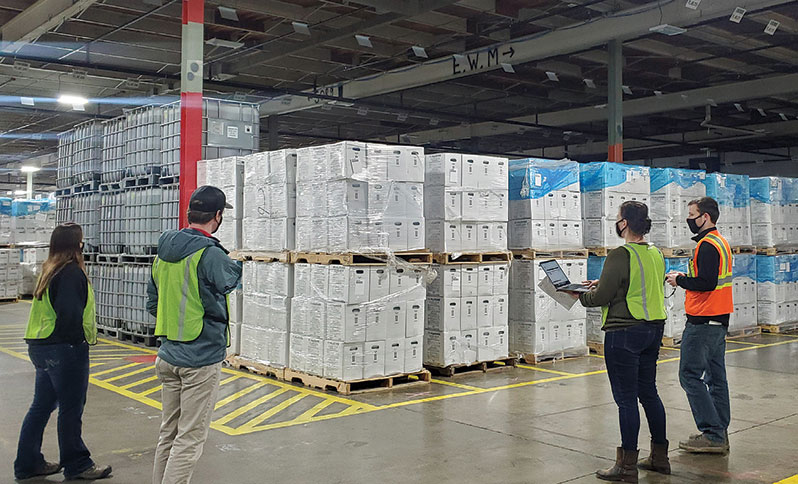The pluses propelling cloud warehouse management systems (WMS)
The cloud-based subscription model for acquiring and running warehouse management system software has gained ground, but some misgivings persist. The model’s value propositions are evolving around factors like bypassing the need for big upgrade projects or offloading worries about tuning a WMS.

The concept and practice of running warehouse management system (WMS) software through cloud hosting and subscription arrangements, rather than deploying WMS in-house, is no new kid on the block. Leading WMS vendors have had cloud options for many years. Yet cloud isn’t quite the dominant model for WMS as it is in some other enterprise software niches.
What might be holding cloud WMS back? According to WMS vendors and market observers, the reasons why cloud WMS has been slow to develop range from its relative maturity as a software niche to concerns about data intrusion under “multi-tenant” architecture to the view that on-premise costs, at least for the software, are less costly over the longer term.
On the plus side for cloud WMS, it’s steadily become the most common choice for new WMS deals, especially among small to medium enterprises (SMEs). Vendors are also touting how cloud WMS leaves heightened data security concerns to global specialists in security, as well as offloading any internal information technology (IT) worries about tuning WMS IT infrastructure to handle peaks in order fulfillment volumes.
“It really comes down to vendors helping the top decision makers—the C-level–fully understand the value proposition behind cloud WMS,” says Howard Turner, director of supply chain execution systems with St. Onge Company, a supply chain consulting firm.
It’s not like cloud WMS is in a rut. It’s considered to be the leading acquisition model for new WMS solutions, but the software has been around for many decades, and the base of installed on-premise systems in the market is huge, making the overall market shift to cloud slow.
According to Dwight Klappich, research vice president and fellow with analyst firm Gartner, while Gartner hasn’t surveyed the market to determine the exact breakdown between cloud and on-premise WMS for a few years, cloud is winning out on new deals, based on trends from client inquiries and interactions. “WMS solutions have finally evolved to a cloud-first market where more than 75% of new WMS deals are now cloud,” Klappich says.

Cloud headwinds
Cloud WMS hasn’t taken over completely for a few reasons. For one, notes Klappich, WMS is a global market, and in some regions cloud computing faces resistance due to concerns about data security, and in some places, telecom bandwidth.
While cloud WMS vendor fees vary, says Turner, as a general rule, subscription fees under a software-as-a-service (SaaS) model significantly cut upfront implementation costs versus on-premise deals, since license fees are spread out on an operational or “OpEx” basis, with no server hardware to acquire.
However, some potential user companies project software costs over a longer horizon, say five years or more, and figure running a WMS on-site, even with an annual maintenance fee, is less costly over the long haul, Turner notes.
But a narrow outlook on cloud software costs versus on-premise software costs may overlook some key advantages of the cloud model, adds Turner. One of the most important is that with cloud and SaaS, vendors regularly send out updates to the system to keep users on the latest software. That can avoid big “migrations” to new WMS versions every few years, which Turner notes “can end up being almost as costly as the original project.”
WMS providers agree. “All new customers and upgrades for Tecsys’ Elite WMS are now exclusively cloud based,” says Bill Denbigh, vice president of product marketing at Tecsys. “We have made this transition to leverage cloud technology, which enables us to offer our customers enhanced service levels, reduced costs, and the ability to provide continuous updates. By moving to the cloud, we eliminate the need for on-premise installations and ensure customers always have access to the latest versions of our solution.”
Another evolving driver is the increased risk of sophisticated ransomware attacks over the last several years, notes Denbigh. “Many customers realize they either struggle to maintain adequate security measures, regular backups and failover capabilities on their own, or they simply don’t have the resources to do so effectively. By moving to the cloud, customers no longer have to worry about these complex and costly tasks,” he says. “They can rely on our expertise and infrastructure to ensure their systems are properly managed, secure and protected.”
Adapting to peak
Customer concerns about data security, but also the increasing complexity of optimizing systems to perform well to support peaks in business volume are driving organizations toward cloud WMS, says Amit Levy, executive vice president of customer solutions and strategy at Made4Net. On the other hand, he adds, some companies still insist on an on-premise option, or if they are interested in cloud, they prefer to avoid the concept of a multi-tenant architecture, and have a dedicated cloud environment.
With Made4Net’s WMS offering, these considerations mean giving users options, including cloud WMS that runs in a private cloud environment, and also on-premise options, including a subscription-based on-premise option that factors in the end-user is running the IT infrastructure, Levy explains.
“WMS is a mission critical system, and I think that people have learned to accept that cloud WMS can work well, if it is done right, but there are companies with real concerns,” Levy says.
Under Made4Net’s private cloud approach, it partners with major cloud infrastructure providers who have deep expertise in areas like data security and data center load balancing. Each company has its own dedicated cloud, which removes data intrusion concerns some companies may have about multi-tenancy, Levy adds. “There are companies who essentially will say, ‘wait, I don’t want my data to be in the same database with other customers that are using your system,’” he says. “They just don’t want any chance at all of data access by others, even if that chance is the slimmest of the slim.”
Dedicated private cloud offers the advantage of offloading the IT burdens of running a WMS, which along with a subscription model are two key advantages companies are after, notes Levy. They also want a modern, modular system that uses a microservices architecture to make it flexible as an operations system, but overall, they don’t want the IT headaches of securing the data and tuning the IT environment.
Levy, whose background is in IT, says running a WMS in-house today takes significant expertise in areas like database management and knowing how to tune virtualized server resources, so much so that many don’t want to take it on. “There are some companies that have the IT resources and expertise to do this on their own, but that doesn’t always necessarily apply to the market we are playing in, which is the high end of the mid-market and edging into the lower end of Tier 1 enterprises.”
The level of volatility in peak seasons is an under-appreciated factor driving interest in cloud WMS offerings that tap leading infrastructure partners, adds Levy.
“With cloud WMS, you don’t have to worry about increasing data center resources or otherwise reconfiguring the backend properly to handle spikes in fulfillment volume, because we do all that for you,” says Levy.
Some companies do prefer a private cloud for WMS, Denbigh says. Tecsys offers two WMS cloud solutions: Elite, a higher-end market solution hosted on AWS under a private cloud; and Omni, a mid-market cloud WMS that can be deployed in a private cloud or on a shared server with Microsoft Azure as the infrastructure partner. Neither of these solutions are multi-tenant, adds Denbigh, and especially within the Elite target market, there are customers who prefer to keep their data separate, or have regulatory requirements that prohibit data co-mingling.
Remote implementation
Another way cloud WMS helps end-users is supporting remote implementation, says Smitha Raphael, chief product and delivery officer with SnapFulfil, a cloud WMS provider and part of Synergy Logistics.
SnapFulfil’s WMS has been cloud based since its inception 14 years ago, and prior to the pandemic, it began doing remote implementations as a way to further accelerate time to value, Raphael explains. Remote implementation, she adds, is made simpler by the fact that with a cloud WMS, there is no set-up of on-premise servers or database.
While technically, an on-premise WMS could be implemented remotely, it would likely call for a special layer of secure remote access software to permit the WMS vendor to assist with setup of IT infrastructure, and many user companies don’t want any outside access into internal IT networks, Raphael explains.
By contrast, with a cloud WMS, both the vendor and end user company can securely access the application software as it’s being deployed to check configurations are functioning as planned, with SnapFulfil’s hosting partner providing secure access from anywhere with an Internet connection.
Other cloud-based tools can help with remote implementation, says Raphael, including device management software for remotely provisioning and managing devices used with the WMS, such as RF handhelds. SnapFulfil’s implementation staff also use Microsoft Teams for video conferencing to train users and walk them through any set-up questions. With SnapFulfil, she adds, the configurations use pull-down choices and other graphical settings that don’t require programming skills, though sometimes users want a Teams meeting to discuss options or check how a configuration functions.
Today with remote implementation, Raphael says, most deployments can be finished in 45 days, compared with closer to 60 days several years back with on-site projects.
“We’ve found that with cloud WMS, excellent support tools and remote implementation, deployments happen much faster compared with on-site, and it doesn’t take away from the user experience or the functional objectives of the project,” Raphael says. “Overall, we’ve found remote implementation speeds up time to value for our customers, and for us, it makes better use of our resources, because we can have different team members in different time zones assist when needed, as opposed to having to wait for a team member located at one physical site to answer the concern.”
SnapFulfil also embraces a train-the-trainer approach combined with remote implementation where designated people at the end-user company are trained as “super-users” of the system, with those people able to lead future implementations.
Raphael says this results in a do-it-yourself (DIY) approach to rapid, remote WMS implementation, which is useful for rollouts to multiple sites, using the first deployment as a blueprint for how the business wants the software configured.
This DIY-approach enabled one of SnapFulfil’s users, Farmers Business Network (FBN), a farmer-to-farmer network and ag-tech company with an online store and a distribution network that spans North America, to rapidly deploy SnapFulfil to 20 warehouses sites in the U.S. and Canada. SnapFulfil’s remote implementation team led the first deployment of the system for a warehouse in Iowa, assisted heavily with a couple of more, and FBN’s super-user took it from there to rapidly lead deployment to the rest of the sites with minimal assistance from SnapFulfil.
The result was that FBN was able to rollout SnapFulfil to 20 sites all within 15 months, all during the pandemic, when agriculture and food industry needed to be more agile than ever.
The value proposition for cloud solutions has long centered on reducing IT overhead and concerns, and essentially that hasn’t changed, though it has evolved to address growing user concerns around data security, and offloading the IT complexity of keeping WMS infrastructure resilient and responsive to operational peaks.
At the same time, notes Denbigh, the notion that cloud WMS forces users onto rigid software that doesn’t allow for business-specific configurations, has diminished as users see cloud software can be adapted to company requirements with those settings carrying forward through frequent updates to the core system.
“SaaS solutions have evolved to offer low-code/no-code add-ons, allowing users to adapt the system to their specific needs, thus addressing the issue of control and adaptability,” Denbigh says. “Additionally, the increasing prevalence of sophisticated hacking and denial of service attacks has made companies realize the value of partnering with experts in data security. As more stories of security breaches become known, companies are recognizing the importance of having well-run SaaS solutions backed by deep expertise in data security and risk mitigation. This trend is contributing to a shift in mindset toward embracing cloud-based WMS solutions.”

Article Topics
Gartner News & Resources
Gartner foresees sizeable uptake for next-gen humanoid robots Gartner survey finds 49% of supply chain organizations have formal DEI objectives The pluses propelling cloud warehouse management systems (WMS) Gartner: 26% of supply chain C-suite roles now filled by women What’s keeping the supply chain C-Suite up at night? Materials handling robot basics Talking Supply Chain Podcast: Insights on leaders: The Top 25 More GartnerLatest in Materials Handling
Geek+ and System Teknik deploy PopPick solution for pharmacy group Med24.dk Beckhoff USA opens new office in Austin, Texas Manhattan Associates selects TeamViewer as partner for warehouse vision picking ASME Foundation wins grant for technical workforce development The (Not So) Secret Weapons: How Key Cabinets and Asset Management Lockers Are Changing Supply Chain Operations MODEX C-Suite Interview with Harold Vanasse: The perfect blend of automation and sustainability Consultant and industry leader John M. Hill passes on at age 86 More Materials HandlingAbout the Author
Subscribe to Materials Handling Magazine

Find out what the world's most innovative companies are doing to improve productivity in their plants and distribution centers.
Start your FREE subscription today.
April 2024 Modern Materials Handling

Latest Resources











